7-(Diethylamino)coumarin-3-carboxylic acid
- CAS NO.:50995-74-9
- Empirical Formula: C14H15NO4
- Molecular Weight: 261.27
- MDL number: MFCD00068721
- SAFETY DATA SHEET (SDS)
- Update Date: 2024-11-19 23:02:33
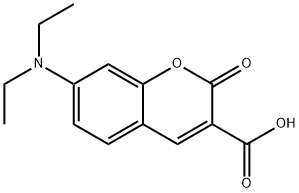
What is 7-(Diethylamino)coumarin-3-carboxylic acid?
The Uses of 7-(Diethylamino)coumarin-3-carboxylic acid
7-(Diethylamino)coumarin-3-carboxylic acid is an amine-reactive fluorescent label used for protein conjugation.
The Uses of 7-(Diethylamino)coumarin-3-carboxylic acid
7-(Diethylamino)-coumarin-3-carboxylic acid is a reagent for the derivatisation of amines and proteins. It has also been used for labelling synthetic peptides for high-throughput detection.
What are the applications of Application
7-(Diethylamino)coumarin-3-carboxylic acid is an amine-reactive fluorescent label used for protein conjugation
Properties of 7-(Diethylamino)coumarin-3-carboxylic acid
| Melting point: | 222-224 °C (dec.)(lit.) |
| Boiling point: | 464.7±45.0 °C(Predicted) |
| Density | 1.317±0.06 g/cm3(Predicted) |
| storage temp. | Keep in dark place,Inert atmosphere,Room temperature |
| solubility | DMF: soluble |
| form | Solid |
| pka | -98.36 ± 0.20, most acidic, temperature:
25 °C; 6.06 ± 0.20, most basic(at 25℃) |
| color | Bright orange solid; Orange crystals;
Orange crystalline solid; Orange laths; Orange
powder; Orange solid |
| λmax | 409 nm (Buffer pH 9.0) |
| BRN | 6145963 |
| Major Application | Epoxy resinsphotoluminescent devices;lithographic platematerials; oil-repellent copolymers/coatings;polymer matrices; silica nanoparticles for imaging,security, and sensing applications |
| Biological Applications | Detecting hydrogenperoxide; evaluating iron ions; cysteine cathepsinsinhibitors; β-glucosidase inhibitors; humanmonoamine oxidase inhibitors; N-Methyl-D-aspartatereceptors (NMDARs) inhibitors; phosphateassay; probing actomyosin mechanism;treatingcancer/antitumor activity,treating cognitive deficits orschizophrenia;as a substrate for measuring proteinkinase activity |
Safety information for 7-(Diethylamino)coumarin-3-carboxylic acid
| Signal word | Warning |
| Pictogram(s) |
 Exclamation Mark Irritant GHS07 |
| GHS Hazard Statements |
H315:Skin corrosion/irritation H319:Serious eye damage/eye irritation |
| Precautionary Statement Codes |
P264:Wash hands thoroughly after handling. P264:Wash skin thouroughly after handling. P280:Wear protective gloves/protective clothing/eye protection/face protection. |
Computed Descriptors for 7-(Diethylamino)coumarin-3-carboxylic acid
New Products
4-Fluorophenylacetic acid 4-Methylphenylacetic acid N-Boc-D-alaninol N-BOC-D/L-ALANINOL Tert-butyl bis(2-chloroethyl)carbamate 3-Morpholino-1-(4-nitrophenyl)-5,6-dihydropyridin- 2(1H)-one Furan-2,5-Dicarboxylic Acid Tropic acid S-2-CHLORO PROPIONIC ACID ETHYL ISOCYANOACETATE 2-Bromo-1,3-Bis(Dimethylamino)Trimethinium Hexafluorophosphate (6-METHYL-[1,3]DITHIOLO[4,5-b]QUINOXALIN-2-ONE INDAZOLE-3-CARBOXYLIC ACID 4-IODO BENZOIC ACID (2-Hydroxyphenyl)acetonitrile 4-Bromopyrazole 5,6-Dimethoxyindanone 2-(Cyanocyclohexyl)acetic acid 4-methoxy-3,5-dinitropyridine 2-aminopropyl benzoate hydrochloride 1-(4-(aminomethyl)benzyl)urea hydrochloride diethyl 2-(2-((tertbutoxycarbonyl)amino) ethyl)malonate tert-butyl 4- (ureidomethyl)benzylcarbamate Ethyl-2-chloro((4-methoxyphenyl)hydrazono)acetateRelated products of tetrahydrofuran
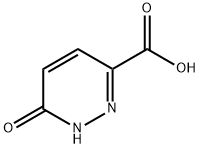
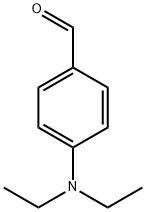
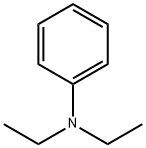


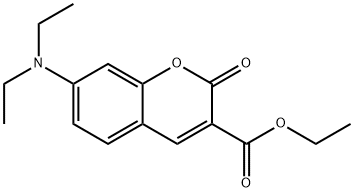
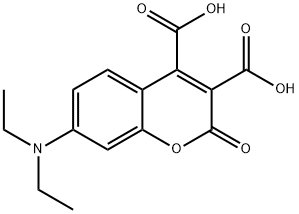

You may like
-
 7-(Diethylamino)coumarin-3-carboxylic Acid CAS 50995-74-9View Details
7-(Diethylamino)coumarin-3-carboxylic Acid CAS 50995-74-9View Details
50995-74-9 -
 7-(Diethylamino)coumarin-3-carboxylic acid CAS 50995-74-9View Details
7-(Diethylamino)coumarin-3-carboxylic acid CAS 50995-74-9View Details
50995-74-9 -
 1975-50-4 98%View Details
1975-50-4 98%View Details
1975-50-4 -
 2-HYDROXY BENZYL ALCOHOL 98%View Details
2-HYDROXY BENZYL ALCOHOL 98%View Details
90-01-7 -
 2-Chloro-1,3-Bis(Dimethylamino)Trimethinium Hexafluorophosphate 221615-75-4 98%View Details
2-Chloro-1,3-Bis(Dimethylamino)Trimethinium Hexafluorophosphate 221615-75-4 98%View Details
221615-75-4 -
 61397-56-6 CIS BROMO BENZOATE 98%View Details
61397-56-6 CIS BROMO BENZOATE 98%View Details
61397-56-6 -
 14714-50-2 (2-Hydroxyphenyl)acetonitrile 98+View Details
14714-50-2 (2-Hydroxyphenyl)acetonitrile 98+View Details
14714-50-2 -
 118753-70-1 98+View Details
118753-70-1 98+View Details
118753-70-1
Statement: All products displayed on this website are only used for non medical purposes such as industrial applications or scientific research, and cannot be used for clinical diagnosis or treatment of humans or animals. They are not medicinal or edible.